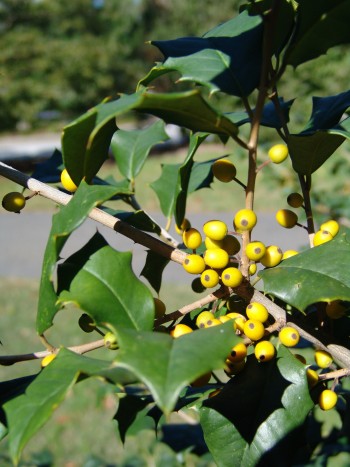Hollies at the Scott Arboretum
When I was the curatorial intern here at the Scott Arboretum, I was given the task of producing the annual evaluation and report of our James R. Frorer Holly collection which would be then given to the Holly Society of America. I remember quiet afternoons by myself tromping around in the snow, checking accession tags, assessing the fruiting and general health of the trees. This is when I realized what an incredible collection we have here at Scott, and how much I enjoy spending time in it. The collection is a designated National Holly Arboretum by the Holly Society of America and is part of the North American Plant Collections Consortium. It is located next to the Palmer Meadow along the Crum Creek and is a wonderful place to visit year-round. The fall and winter seasons are especially pleasant because of the fruiting hollies and the variety of bird species that are attracted to them. Many hollies are wonderful additions to the garden to add year-round interest and colorful berries during the winter.
There are around 400 species of the genus Ilex, one of the two genera of the Aquifoliaceae family. Here at the Scott Arboretum, we have over 350 different species, cultivars, and hybrids in various locations around the Arboretum, many concentrated heavily in the Frorer Holly Collection. Ilex opaca, the American holly, is the most represented species in the collection, with over 90 cultivars, and there are also several wonderful specimens throughout the Scott Arboretum. My favorite specimens of the straight species are in front of Parrish Hall. All year these magnificent trees offer structure, texture, and color to the facade of Parrish. This tree is native to eastern North America and can grow to 60 feet tall. The leaves are spiny-toothed and elliptical and remain evergreen throughout the year. The species name opaca refers to the opaque, non-lustrous surface of the leaf. Many kinds of songbirds, gamebirds, and mammals eat the berries which ripen in October and which are usually red, but can be yellow or orange depending on the cultivar, like Ilex opaca ‘Canary’. American hollies are also deer-resistant. These trees thrive in full sun to partial shade and are hardy in USDA zones 5 through 9.
Holly has been used as a symbolic winter decoration since the Celtic peoples of Northern Europe who decorated their homes with it during the winter solstice, or Yule. Don’t forget to come to our 5th annual Greens Sale on Tuesday, December 9th from noon to 6 pm. Fresh cut greens, do-it-yourself wreath kits, and completed green wreaths will be available for purchase for you to decorate your home.








Andrew Bunting
Posted at 14:58h, 03 DecemberNice blog. My favorites are ‘Old Heavyberry’, ‘Satyr Hill’ and ‘Boyce Thompson Xanthocarpa’.